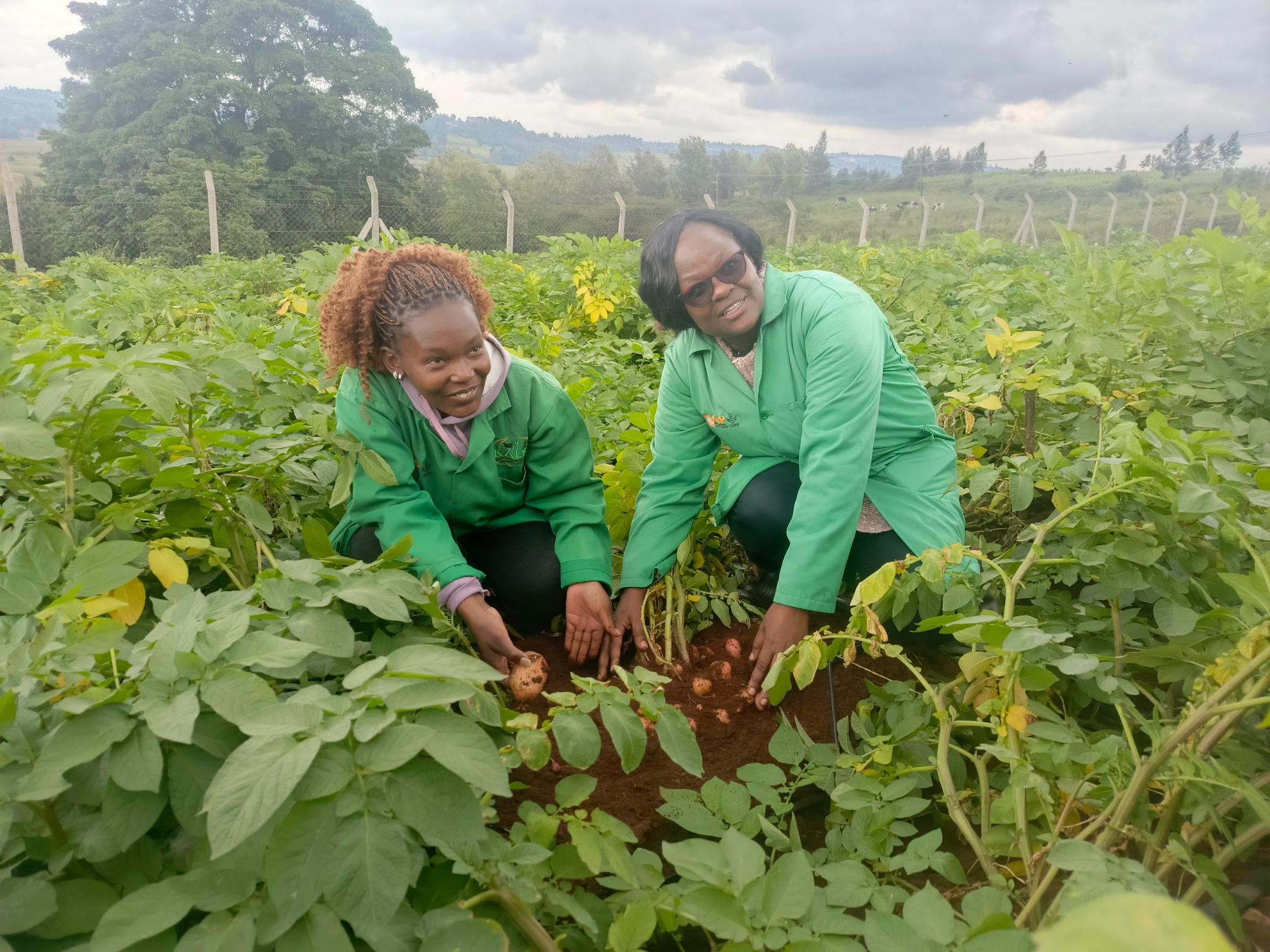
Nema seeks views on hardy GMO potatoes
It aims to cut losses and reduce reliance on potentially harmful fungicides
Resistance confirmed in confined trials and GM potato could be ready for release by October next year, Kalro scientists say.
In Summary

Audio By Vocalize
 Miriam Mbiyu, a research scientist at the Kenya Agriculture and Livestock Research Organisation and Charity Nzilani, an assistant trial manager at the GMO potato confined field trial site at Kalro-Muguga /AGATHA NGOTHO
Miriam Mbiyu, a research scientist at the Kenya Agriculture and Livestock Research Organisation and Charity Nzilani, an assistant trial manager at the GMO potato confined field trial site at Kalro-Muguga /AGATHA NGOTHOFarmer Harun Waweru has grown potatoes for many years in Nyandarua—for home consumption and a source of income.
Potato farming can be profitable, but diseases, such as late blight, have repeatedly left many farmers devastated.
“We are losing money to produce potatoes for bigger markets, but in the end, many farmers are unable to recover what they invested,” Waweru said.
Constant use of fungicides is expensive, yields are often low and this discourages many smallholders.
Waweru said the new GM potato being developed could be a game changer and a major relief for farmers, if it proves truly resistant to late blight.
The disease caused the Irish Potato Famine, or Great Hunger, in the 1840s, which quickly spread worldwide, causing mass starvation, deaths and population flight.
The Kenya National Potato Council calls late blight one of the most destructive diseases affecting potatoes and other crops including eggplants, bell peppers, tomatoes, tobacco and chilli peppers.
In Kenya, resistance has been confirmed in confined trials and a GM potato variety could be ready for release by October next year, Kalro scientists say.
Researchers at the Kenya Agriculture and Livestock Research
Organisation (Kalro), working with partners, are developing a genetically
modified variety resistant to late blight.
According to Dr Moses Nyongesa, a potato researcher at Kalro, potatoes are the second most important crop in Kenya after maize, grown by between 800,000 and one million farmers. It supports about 3.5 million Kenyans and contributes about Sh50 billion annually to the economy.
Late blight remains the biggest threat. A report by the International Potato Centre (CIP) shows the disease can cause yield losses of up to 80 per cent in Kenya. Globally, farmers lose about 16 per cent of potato production to late blight and spend more than $10 billion (about Sh1.3 trillion) annually on fungicides.
“This disease spreads very fast under humid and wet conditions. Within one to two weeks, an entire crop can be wiped out if no control is applied,” Nyongesa explained.
“Currently, farmers rely heavily on fungicides, but these are costly, not always available, and sometimes misused, exposing farmers and the environment to risks.”
To overcome this, researchers turned to biotechnology. Nyongesa said they identified three resistance genes, known as 3R genes, from wild potato relatives. Using genetic engineering, Kenyan scientists inserted these genes into popular local varieties such as shangi, asante and Tigoni.
“The introduction of these resistance genes gives potatoes durable protection against late blight,” he said.
“This means farmers will require little to no fungicides, improving yields, reducing costs and ensuring better-quality harvests.”
Trials carried out in laboratories, greenhouses and confined fields across counties such as Kiambu, Nyandarua and Nakuru, have shown promising results.
Researchers are now preparing for national performance trials under the supervision of the Kenya Plant Health Inspectorate Service, a key regulatory step before release.
Dr Miriam Mbiyu, a research scientist at Kalro-Muguga, said conventional breeding takes 10–15 years to develop a resistant potato variety, but biotechnology has made it possible to shorten this process significantly.
“We have already confirmed resistance in confined trials, and if all goes well, Kenya could have a GM potato variety ready for release by October next year,” she said.
Beyond Kenya, late blight-resistant GM potato research is also underway in Rwanda, Uganda and Nigeria.
Dr Paul Chege, a plant scientist and senior programmes officer at ISAAA AfriCentre, pointed out that GM crops are not new.
ISAAA is the International Service for the Acquisition of Agri-biotech Applications.
“Globally, 29 countries are already cultivating GM crops
across more than 200 million hectares (about 494 million acres). In Africa, we have Bt cotton in Kenya, GM
maize and soybean in South Africa, and Bt cowpea in Nigeria and Ghana,” he
said.
Chege said farmers who will adopt the GM potato will benefit from reduced production cost and labour, since they will no longer need to spray up to 13 rounds of fungicides per season.
“This technology is beneficial not just for farmers’ incomes, but also for human health and the environment,” he said.
Researchers say if adopted, the GM potato could increase farmers’ incomes by at least 34 per cent per hectare, while strengthening food security and reducing chemical use in potato production.
Currently, the GM potato is undergoing regulatory review, including environmental and biosafety assessments.
Public participation is ongoing before approvals can be granted. If cleared, the variety will proceed to national performance trials, and eventually, commercial release.
The disease spreads rapidly through infected plant material, favourable weather conditions, and the emergence of more aggressive, fungicide-resistant strains.
Late blight is caused by a water mould, phytophthora infestans, which can survive in infected plant debris and soil, making it difficult to eradicate.
Symptoms typically begin as water-soaked spots on the tips or edges of lower leaves where dew collects. In cool, moist conditions, these spots expand quickly, often surrounded by yellow halos, eventually destroying the foliage and devastating yields.
Instant analysis
A new GM potato resistant to late blight has been developed and piloted. It could be a game changer and increase yields and profits for farmers who spend a lot on fungicides and frequent spraying. If it clears regulatory hurdles, it could be ready for release in October next year.

It aims to cut losses and reduce reliance on potentially harmful fungicides